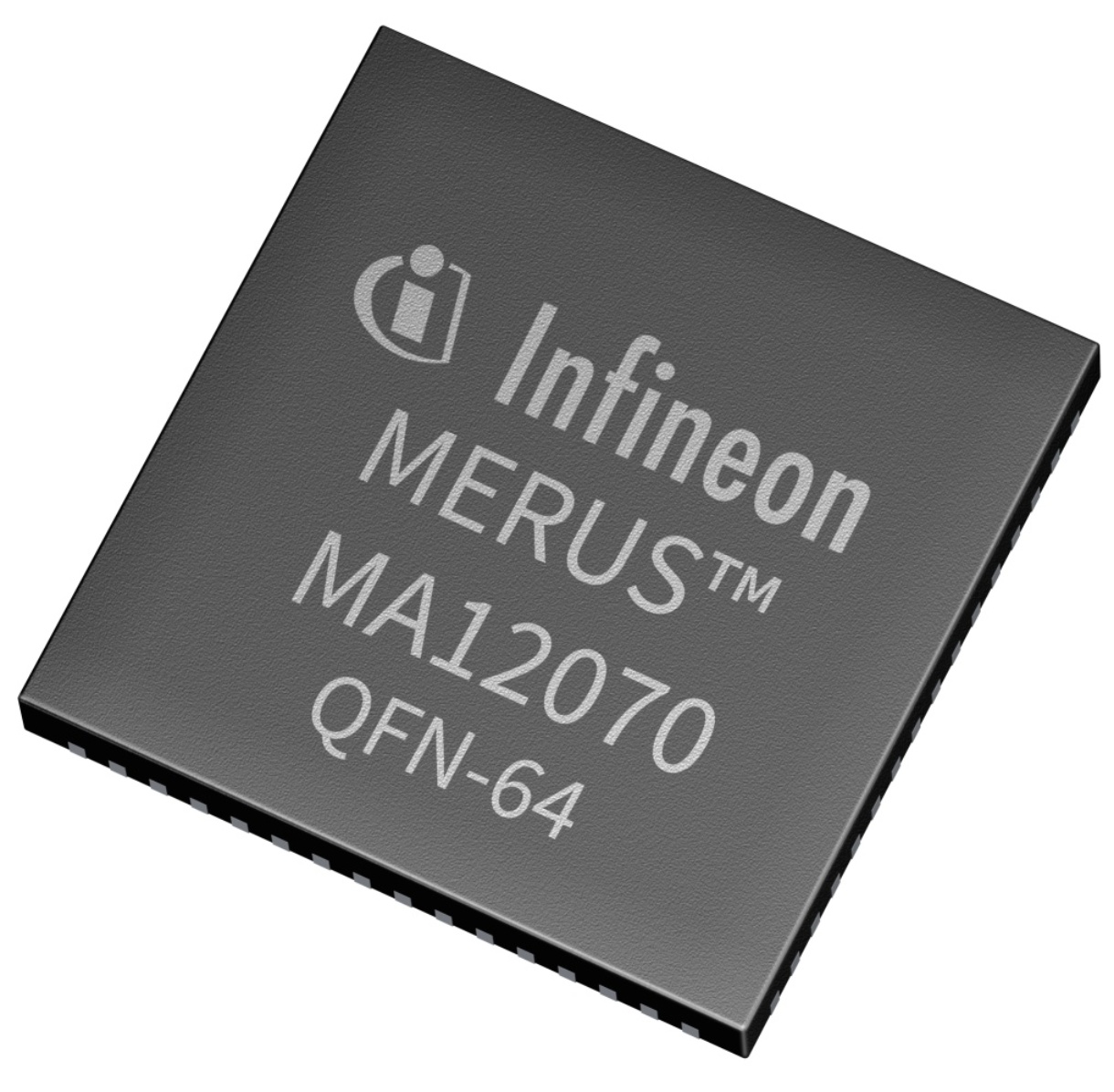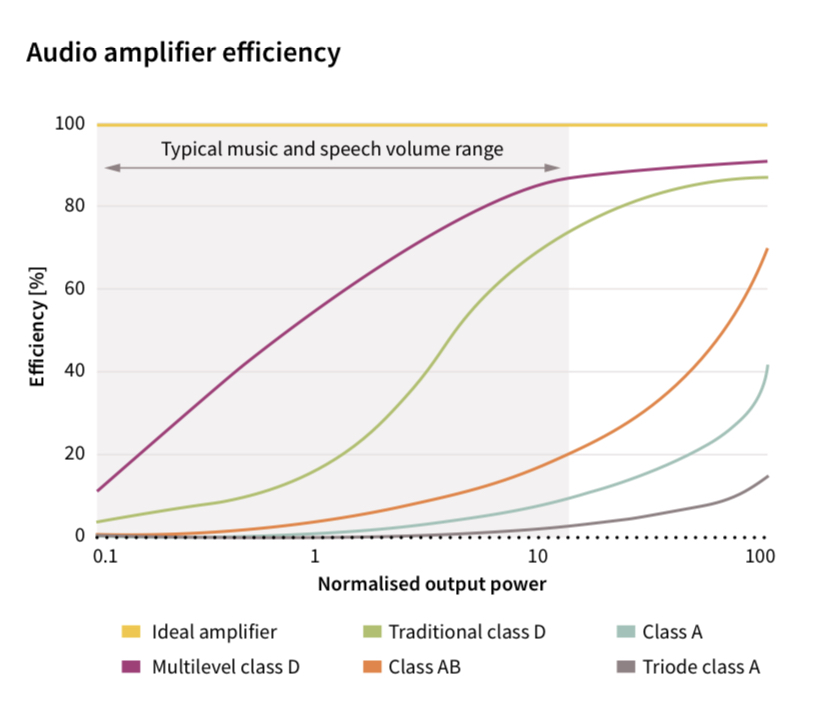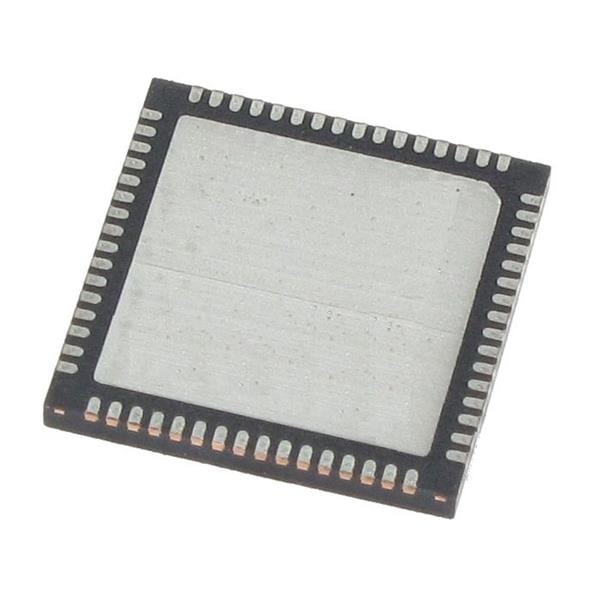Just saw this new amp IC being used in the SMSL SA300. The specs look impressive. 45uV noise with audio source off. 0.004% THD at higher power (not sure what power but not max). Max power in the usual 40w range for 24v supplies. Built in I2C serial data bus for DSP programming and basic controls.

Features from website:
MA12070 - Infineon Technologies
https://www.infineon.com/dgdl/Infin...N.pdf?fileId=5546d46264a8de7e0164b750002861a5
Uses the so-called Multilevel Class D topology for the highest power efficiency, greater than traditional Class D - whitepaper:
https://www.infineon.com/dgdl/Infin...N.pdf?fileId=5546d462696dbf120169b4f8f7524db9
Applications:
https://www.infineon.com/dgdl/Infin...N.pdf?fileId=5546d462677d0f460167bba4f4e81abd
The SMSL SA300 which has got to be the highest feature packed per dollar DAC/amp I have seen.
If anyone has experience with this new chip please share. Getting the SA300 is less expensive than getting the Eval board from Infineon.
Is this the new “TPA3116 Juggernaut” of the 2020 decade?

Features from website:
Summary of Features

Multi-level switching technology with 3-level and 5-level modulation
2×80W peak output power (26V PVDD, RL = 4Ω, 10% THD+N level)
Supply voltages: +4V to +26V (PVDD) and +5V (A/DVDD)
Suitable for 2.0, 2.1, 4.0, 1.0 output stage configurations
4th order feedback error control
<160mW Idle power dissipation (26V PVDD, all channels switching)
>80% efficiency at 2W power (1kHz sine, 8Ω)
>91% efficiency at full Power (1kHz sine, 8Ω)
Audio performance (PMP2): >110dB SNR (A-w, rel. to 1% THD+N power level)
45µV output integrated noise (A-w)
0.004% THD+N at high output levels
I2C control (four selectable addresses)
Built-in protection: under-voltage-lockout, over-temperature warning/error, short-circuit/overload protection, power stage pin-to-pin short-circuit, error-reporting through serial interface (I2C), DC protection
MA12070 - Infineon Technologies
https://www.infineon.com/dgdl/Infin...N.pdf?fileId=5546d46264a8de7e0164b750002861a5
Uses the so-called Multilevel Class D topology for the highest power efficiency, greater than traditional Class D - whitepaper:
https://www.infineon.com/dgdl/Infin...N.pdf?fileId=5546d462696dbf120169b4f8f7524db9
Applications:
https://www.infineon.com/dgdl/Infin...N.pdf?fileId=5546d462677d0f460167bba4f4e81abd
The SMSL SA300 which has got to be the highest feature packed per dollar DAC/amp I have seen.
If anyone has experience with this new chip please share. Getting the SA300 is less expensive than getting the Eval board from Infineon.
Is this the new “TPA3116 Juggernaut” of the 2020 decade?
Attachments
Last edited:
Must use solder paste and hot plate and skillet. Or preferably, hot plate on bottom and hot air pencil on top. The pads are self-aligning via surface tension of molten solder when liquidus. Many state of the art parts are now in this format, so we as DIY'ers, are going to have to expand our repertoire of construction to match if we want to play with state of the art parts. It is not that hard really. Watch some videos on YouTube, get solder paste in syringe, get a $10 hot plate and an old frypan.
QFN64 with thermal pad down package looks like this on bottom side:

QFN64 with thermal pad down package looks like this on bottom side:

Last edited:
Looks interesting with impressive specs but for DIY a horror to solder.
drag solder, lots of flux and a usb microscope. something any DIY modern workshop should have.
I have managed with the fine soldering iron tip to let a solder-drop run along the sides and remove any excessive solder that way. Leads on 4 sides I still find difficult to handle with traditional soldering gear. OK, this is a chip that is not meant to be used with a heatsink. Once on the board, it is not meant to leave again.
My main irritation is chips like TDA7498E with very tiny leads. The TDA7498E anyway needs a solid heatsink on top so why not use an SMT chip housing like for TDA8932 or TDA8954 that is somewhat bigger but much easier to handle.
My main irritation is chips like TDA7498E with very tiny leads. The TDA7498E anyway needs a solid heatsink on top so why not use an SMT chip housing like for TDA8932 or TDA8954 that is somewhat bigger but much easier to handle.
Must use solder paste and hot plate and skillet. Or preferably, hot plate on bottom and hot air pencil on top. The pads are self-aligning via surface tension of molten solder when liquidus. Many state of the art parts are now in this format, so we as DIY'ers, are going to have to expand our repertoire of construction to match if we want to play with state of the art parts. It is not that hard really. Watch some videos on YouTube, get solder paste in syringe, get a $10 hot plate and an old frypan.
QFN64 with thermal pad down package looks like this on bottom side:

ok as attachment the size seems near real size, tiny, will have to wait for mini ampboards
Attachments
Last edited:
It seems the output stages PMP0 and PMP3 have more noise around 6khz, the figures for PMP1 and PMP2 are much better.
Further down in the BTL sections you see the numbers on PMP1 are also starting to look better than PMP2.
I would expect about 20 decent quality watts in 8ohms/BTL 26V.
Page 38 onwards for 8ohms 26v BTL, page 53 onwards for 8ohms 24v BTL.
https://www.infineon.com/dgdl/Infin...N.pdf?fileId=5546d46264a8de7e0164b750002861a5
No SQ competition for TPA3250/TPA3251 IMO, but a very good start. Better than TPA3118?
Seems a little bit easier to DIY perhaps.
Further down in the BTL sections you see the numbers on PMP1 are also starting to look better than PMP2.
I would expect about 20 decent quality watts in 8ohms/BTL 26V.
Page 38 onwards for 8ohms 26v BTL, page 53 onwards for 8ohms 24v BTL.
https://www.infineon.com/dgdl/Infin...N.pdf?fileId=5546d46264a8de7e0164b750002861a5
No SQ competition for TPA3250/TPA3251 IMO, but a very good start. Better than TPA3118?
Seems a little bit easier to DIY perhaps.
Last edited:
Imho, this chip is impressive for battery operated as it's a very efficient chip.
If looking for powerful chip and not battery operated ,I will stick with TPA3255
Unfortunately , we have have to wait for TPA3126 or TPA3156 to compare with since it's consider newer generation / improved design
If looking for powerful chip and not battery operated ,I will stick with TPA3255
Unfortunately , we have have to wait for TPA3126 or TPA3156 to compare with since it's consider newer generation / improved design
If looking for powerful chip and not battery operated ,I will stick with TPA3255
Depends on what battery, I can run 7hrs at 100wrms with a couple of big gel cells and DC-DC step up. Here is my 3255:
Last edited:
Imho, this chip is impressive for battery operated as it's a very efficient chip.
If looking for powerful chip and not battery operated ,I will stick with TPA3255
Unfortunately , we have have to wait for TPA3126 or TPA3156 to compare with since it's consider newer generation / improved design
I would actually prefer the TPA3251 to any of these low-ish power chips (3116, 3118, 3126, 3156 etc), even the TPA3250 (the TPA3250 is a really good one, but it's not quite so versatile and very slightly worse noise figures).
TPA3251 - Good noise figures, works from 12-36vdc (38v max!), can be asked to give about 50 watts very clean power in 8 ohm.
The TPA3255 is the top dog in the right conditions, but I think the TPA3251 is a better "all rounder" all things considered.
Would like to see a 2 x TAS3251 implementation in one board, 4 channels BTL, DSP filters and EQ, and one of those "HD bluetooth" receivers.
Not better, only less clutter.
What is the benefit if using TPA3251, why not just get TPA3255 if performance is tops. BOM cost and build complexity is not any different.
The Merus MA12070 on the other hand, may not have the high power, but for smaller typical 40w applications, it provides reduced complexity given it has some DSP capability built in and the performance specs for THD and noise are excellent.
The Merus MA12070 on the other hand, may not have the high power, but for smaller typical 40w applications, it provides reduced complexity given it has some DSP capability built in and the performance specs for THD and noise are excellent.
To get everything you pay for in the TPA3255 you need 48v psu, it's a usually a little bit more expensive.
The TPA3251 is happy at 36v, easy to just use a 36v power tool lipo if you wanna go lightweight portable, or for stationary use 32-36v brick psu's are cheap.
The TAS3251 beats the MA12070, surely?
The TPA3251 is happy at 36v, easy to just use a 36v power tool lipo if you wanna go lightweight portable, or for stationary use 32-36v brick psu's are cheap.
The TAS3251 beats the MA12070, surely?
I am curious about your listening impressions and measurements comparing TPA3255 vs TPA3116. I know 3255 is suppose to be higher end. But is there any audible difference or just higher power.
Oon
Oon
Are you asking me or x?
Anyway, to me the difference is very big from TPA3116/18 to TPA3250/51/55 in terms of sound quality. I think the biggest reason for this is a lower noise floor, which makes it easier to hear smaller details and probably also helps it sound more dynamic.
The biggest difference between TPA3250 and TPA3255 is mostly how much power and control you have when pushing them hard, on lower volume there is not much to talk about.
Anyway, to me the difference is very big from TPA3116/18 to TPA3250/51/55 in terms of sound quality. I think the biggest reason for this is a lower noise floor, which makes it easier to hear smaller details and probably also helps it sound more dynamic.
The biggest difference between TPA3250 and TPA3255 is mostly how much power and control you have when pushing them hard, on lower volume there is not much to talk about.
Just curious, where did you get your 3255 amp, Aliexpress? Or you built the board from scratch?
Oon
Oon
The 3255 has class leading low noise figures - it is absolutely silent with the source volume off. The distortion is also lower and with the right implementation using quality parts, I find that the sound quality rivals some of my Class A amps in many ways. But the huge power reserve gives it incredible dynamics for high power low sensitivity speakers. You can't ignore the power difference. In short, the 3255 or 325x is vastly superior to the 3116/18 - just no comparison. I have listened to both cheap Aliexpress/eBay/Amazon versions that cost $55 (they are all very similar to the TI EVM, but with some errors in the logic as the error lights are on when there is no error condition), and I also have the 3E version that costs $75. Definitely spend the extra $20 for the 3E - it is well worth it. But even the $75 version can't compete with my DIY version which has better layout, post-feedback filter (PFBF) capability, higher quality components (big flat copper wire CoilCraft chokes, all metal thin film resistors, Wima/Panasonic/Silmc caps, high quality opamps, etc.). Dr Mord/Voltwide also make very nice DIY designs that spare no expense as far as component quality goes. The amps ends up costing $200+ though - but in my mind, worth it for the quality and power.
Getting back to the Infinion Merus MA12070 chip, I was impressed by its spec'd noise floor, which is even lower than the TPA3255. So I might have to get one of these SMSL SA300 amps to experience it as the factory EVM board costs more with fewer features.
Getting back to the Infinion Merus MA12070 chip, I was impressed by its spec'd noise floor, which is even lower than the TPA3255. So I might have to get one of these SMSL SA300 amps to experience it as the factory EVM board costs more with fewer features.
Last edited:
Hi XRK,
Thanks for the lengthy reply summarising all that us need to know about the TPA3255. If I had the time to spare would love to try your PCB. But too many things asking for my time now.
Real pity the 3e version doesn't ship to my part of the world.
Oon
Thanks for the lengthy reply summarising all that us need to know about the TPA3255. If I had the time to spare would love to try your PCB. But too many things asking for my time now.
Real pity the 3e version doesn't ship to my part of the world.
Oon
China does not ship to Singapore? You might look at some IRS29092 amps - they actually sound really nice and have gobs of power. Not sure why they are not more popular. Available for like $20 on Aliexpress/eBay for 200W amp. They do require dual rail supplies.
Nice EVK
Hi
I was not aware of the MSL SA300 amp. Yes sure that is a great EVK - Just snoop in on the I2C and take over control. You should be able to play a round with the different power mode profiles.
I am part of the small design team that created MA120x0 and very happy to see our technology out in the open.
My DIY goto is the P version - you get digital interface, volume and limiter function but play with higher noise floor.
I interfaced directly to the ESP32 and give me BT/WLAN audio streaming on a very simple design. Even I can do real DSP stuff in the ESP32, EQ, cross over and dynamic boost for free.
But simple design like the MSL SA300 inspire me to add a good DAC and us the analog input with our a hole lot of complexity and go very low noise floor again 🙂
Hope yo get a change to play with our stuff and I look forward to get you unbiased compare to the TI stuff.
Regards Jakobsen, Copenhagen, Denmark
Hi
I was not aware of the MSL SA300 amp. Yes sure that is a great EVK - Just snoop in on the I2C and take over control. You should be able to play a round with the different power mode profiles.
I am part of the small design team that created MA120x0 and very happy to see our technology out in the open.
My DIY goto is the P version - you get digital interface, volume and limiter function but play with higher noise floor.
I interfaced directly to the ESP32 and give me BT/WLAN audio streaming on a very simple design. Even I can do real DSP stuff in the ESP32, EQ, cross over and dynamic boost for free.
But simple design like the MSL SA300 inspire me to add a good DAC and us the analog input with our a hole lot of complexity and go very low noise floor again 🙂
Hope yo get a change to play with our stuff and I look forward to get you unbiased compare to the TI stuff.
Regards Jakobsen, Copenhagen, Denmark
- Home
- Amplifiers
- Class D
- Infineon MA12070 Class D

